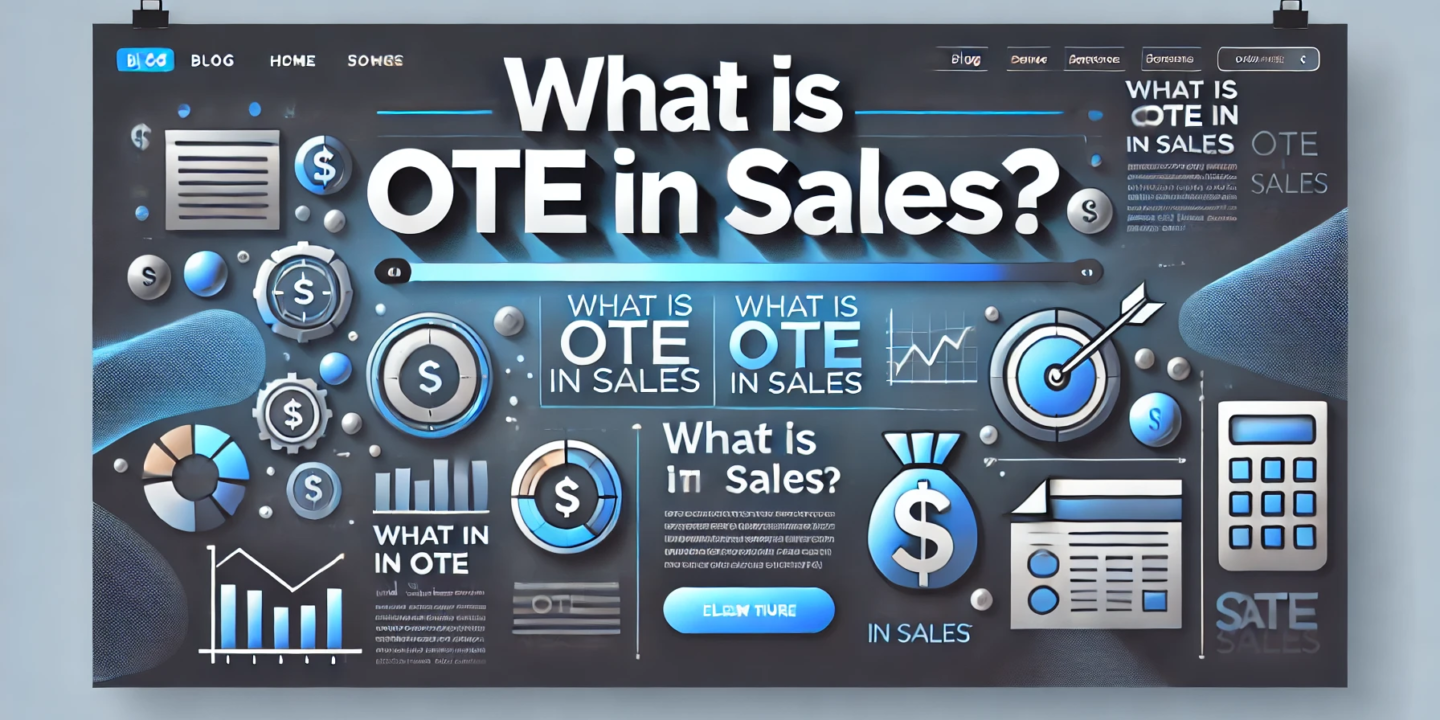
In the dynamic and competitive world of sales, understanding various compensation structures is crucial for both sales professionals and employers. One of the most important and often misunderstood terms in sales compensation is OTE, which stands for On-Target Earnings. This blog, “What is OTE in Sales?” aims to demystify OTE, explaining its significance, how it works, and why it matters in the sales industry.
What is OTE in Sales?

On-Target Earnings (OTE) is a compensation structure commonly used in sales roles. It represents the total potential earnings a sales professional can achieve if they meet all their sales targets. OTE typically includes a base salary plus commissions and bonuses tied to performance metrics. The concept is designed to incentivize salespeople to achieve or exceed their sales goals, aligning their interests with the company’s objectives.
Components of OTE
- Base Salary: This is the fixed component of a sales professional’s compensation. It provides financial stability and is paid regardless of performance. The base salary varies depending on the industry, company size, and the salesperson’s experience and role.
- Commissions: These are variable earnings based on the salesperson’s performance. Commissions are usually a percentage of the sales made. They can be structured in various ways, such as a flat rate for each sale or a tiered system where the percentage increases with higher sales volumes.
- Bonuses: These are additional incentives awarded for achieving specific targets or milestones. Bonuses can be tied to individual performance, team performance, or company-wide goals. They are often paid quarterly or annually.
How OTE Works?
To illustrate how OTE works, let’s consider an example. Suppose a sales representative has an OTE of $100,000. This OTE is composed of a $60,000 base salary and $40,000 in potential commissions and bonuses. Here’s how it might break down:
- Base Salary: $60,000
- Commission Structure: 10% commission on all sales
- Bonus: $10,000 for achieving the annual sales target of $400,000
In this scenario, if the salesperson meets their sales target, they will earn their base salary of $60,000 plus $40,000 in commissions and bonuses, totaling their OTE of $100,000.
Importance of OTE in Sales
- Motivation: OTE serves as a powerful motivator. It incentivizes sales professionals to strive for higher performance, directly linking their earnings to their efforts and results. This alignment of interests benefits both the employee and the employer.
- Transparency: OTE provides clarity and transparency in compensation. Sales professionals know exactly what they need to achieve to earn their full potential, reducing uncertainties and fostering a performance-driven culture.
- Attracting Talent: Competitive OTE packages help attract top sales talent. High-performing sales professionals are often drawn to opportunities where their efforts are rewarded generously, making OTE a crucial factor in recruitment.
- Retention: Offering a clear path to higher earnings through OTE can improve retention rates. Salespeople are more likely to stay with a company that offers substantial rewards for their hard work and success.
What Are the Key Considerations in Calculating OTE?

Calculating OTE involves several factors. Here are some key considerations for employers when determining OTE for sales roles:
- Industry Standards
Different industries have varying benchmarks for OTE. For instance, OTE in technology sales might differ significantly from OTE in retail sales. Employers should research industry standards to ensure their OTE packages are competitive.
- Role-Specific Metrics
The specific sales role and its associated responsibilities influence OTE. For example, an account executive handling large enterprise accounts might have a higher OTE compared to an inside sales representative focusing on small business.
- Market Conditions
Economic conditions and market demand can impact OTE. Companies might adjust OTE packages during economic downturns to reflect changing market realities. Conversely, in booming markets, OTE might be more generous in capitalizing on growth opportunities.
- Performance Metrics
Clear and achievable performance metrics are essential for OTE. These metrics should be aligned with the company’s overall goals and should be challenging yet attainable. Common metrics include sales quota, revenue targets, and customer acquisition goals.
- Balance Between Base Salary and Variable Pay
Striking the right balance between base salary and variable pay is crucial. A well-balanced OTE structure ensures that sales professionals have financial stability while being motivated to exceed their targets. Typically, base salary comprises 50-70% of the OTE, with the remainder coming from commissions and bonuses.
What Are the Challenges With OTE?
While OTE is an effective compensation structure, it comes with its challenges. Both employers and employees need to be aware of these potential pitfalls:
- Unrealistic Targets
Setting unrealistic sales targets can demotivate sales professionals. If the targets are perceived as unattainable, it can lead to frustration and decreased morale. Employers should set challenging but realistic goals to keep their teams motivated.
- Market Fluctuations
Market conditions can impact a salesperson’s ability to meet their targets. Economic downturns, changes in consumer behavior, or increased competition can all affect sales performance. Employers need to consider these factors when setting OTE.
- Inequity in Compensation
Disparities in OTE within a sales team can create a sense of inequity. If some sales professionals consistently earn higher OTE due to favorable territories or customer bases, it can lead to resentment among team members. Employers should strive for fairness and equity in their OTE structures.
- Complexity in Calculation
Complex OTE structures can be confusing for sales professionals. If the calculation of commissions and bonuses is too complicated, it can lead to misunderstandings and disputes. Employers should aim for simplicity and transparency in their OTE formulas.
What Are the Best Practices for Implementing OTE?
To effectively implement OTE, companies should follow these best practices:
- Clear Communication
Communicate the OTE structure clearly to sales professionals. Ensure they understand how their earnings are calculated and what they need to achieve to reach their OTE. Regularly update them on their progress and any changes to the compensation plan.
- Regular Reviews
Conduct regular reviews of the OTE structure to ensure it remains competitive and aligned with company goals. Gather feedback from sales teams to identify any issues or areas for improvement.
- Training and Development
Invest in training and development programs to help sales professionals improve their skills and achieve their targets. Providing ongoing support and resources can enhance their performance and increase their chances of reaching their OTE.
- Performance Tracking
Implement robust performance tracking systems to monitor sales activities and results. Accurate tracking helps in calculating commissions and bonuses accurately and ensures transparency in the OTE process.
- Incentives for Overachievement
Consider offering additional incentives for overachievement. Rewarding sales professionals who exceed their targets can further motivate them to perform at their best and drive exceptional results.
Frequently Asked Questions
Q1. What is an OTE in sales?
Ans. OTE (On-Target Earnings) in sales refers to the total expected earnings of a salesperson, including base salary and potential commission or bonuses, if they meet their sales targets.
Q2. What does 25% OTE mean?
Ans. 25% OTE means that 25% of the salesperson’s total potential earnings come from variable pay like commission or bonuses, with the remaining 75% being the base salary.
Q3. How do you calculate OTE?
Ans. To calculate OTE, add the base salary to the expected commission or bonus earnings if sales targets are met. For example, if the base salary is $50,000 and the potential commission is $30,000, the OTE is $80,000.
Q4. Can you negotiate OTE?
Ans. Yes, OTE can be negotiated. Sales professionals often negotiate higher base salaries, better commission rates, or more attainable sales targets to increase their overall OTE.
Q5. What are the benefits of OTE?
Ans. OTE provides a clear picture of potential earnings, motivating salespeople to meet or exceed targets. It also aligns the interests of the salesperson and the company, driving revenue growth.
Q6. What is an OTE percentage?
Ans. The OTE percentage represents the proportion of variable compensation (commission or bonuses) within the total OTE. For example, a 30% OTE indicates that 30% of earnings are from commissions or bonuses.
Q7. What is included in OTE?
Ans. OTE includes the base salary plus any variable pay such as commissions, bonuses, or incentives that a salesperson can earn by achieving sales targets.
Q8. How accurate is OTE?
Ans. OTE accuracy depends on realistic sales targets and market conditions. While it offers a projection, actual earnings can vary based on the salesperson’s performance and changes in the market.
Conclusion
On-Target Earnings (OTE) is a fundamental concept in sales compensation designed to align the interests of sales professionals with the goals of the company. By offering a combination of base salary, commissions, and bonuses, OTE motivates salespeople to achieve their targets and contributes to a performance-driven culture. While implementing OTE comes with its challenges, clear communication, realistic targets, and regular reviews can help maximize its effectiveness. For sales professionals, understanding OTE is crucial to maximizing their earnings and career growth. For employers, a well-designed OTE structure can attract, motivate, and retain top sales talent, ultimately driving business growth.








No Comments